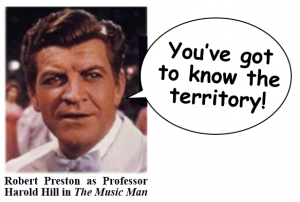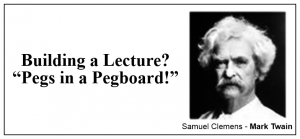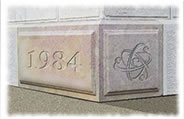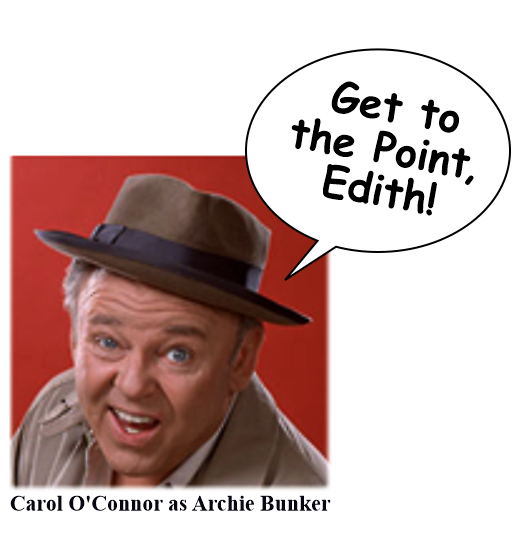Archie, Harold & Sam
Archie Bunker was the lead character from the 70’s sitcom, All in the Family. In lengthy discussions with his wife, Edith, he frequently resorted to the epithet, “Get to the Point, Edith!” Wouldn’t it be heaven to have a red flashing light “Get to the Point!” with a switch by every seat in the conference room? No better way to tell the blowhards, the detail fanatics, and the self- appointed experts that we’re tired of slogging through the endless details than by simply pressing the button and giving them 60 seconds to get to the point?
Why not avoid the flashing light by starting your composition process at the obvious beginning: The End! What’s the point already? What do you want us to do? Why not do bookends? Start and End the presentation with your Intended Next Step! Tell us what you want us to do! Follow with a detailed exposition of what is desired. Follow with the details of why and how. Then finish up with a re-statement of The Point!
Archie Bunker had it right! Get to the Point. Start with the Point. Build up the Point!
Re-State the Point!

In the timeless Meredith Willson musical, a group of traveling salesman on the train in Iowa, compare notes about their trade: the town of River City (and Iowa in general), are deemed tough to sell! The Anvil Salesman nails it with, “You’ve got to know the territory!”
But legend has it, there’s one super salesman, so good that “When the Man Dances, the Piper Pays Him!” His name: Professor Harold Hill, salesman extraordinaire. He sells brass bands — completely equipped brass bands, with uniforms — to entire towns — for the children.
Of course, this can’t be an easy sale, but Professor Hill proves to be incredibly deft at “Audience Analysis.” He hangs unobtrusively around River City just long enough to identify the fears of every parent in town — that their children might get swept up in the evolving culture of the times, and lose their distinctive, down-home charm.
“Well, either you are closing your eyes to a situation you do not wish to acknowledge, or you are not aware of the caliber of disaster indicated by the presence of a Pool Hall in your community! Well, you got trouble my friends! Trouble right here in River City!”
And the answer? A Band of Course! It’s a sure way to “keep the young ones moral after school…”
Well sure it’s crazy, but Harold Hill wasn’t attempting to make intellectual sense. And many audiences are not interested in that either. They have their own unique reasons for taking action, and your challenge as a speaker is to discover and then speak directly to those motivations. We hope that your ethics are somewhat more refined than Harold Hill, but if your audience analysis skills improve to that degree, your success at selling will become the stuff of legend! “Seventy-Six Trombones in the Big Parade!”

In The Making of Mark Twain Tonight, Hal Holbrook explained the great humorist’s approach to building a public lecture: “The lecture format never changes: much like a child’s pegboard toy.” (Funny Story, Serious Story, Inspirational Story, Intermission. Repeat.)
I have a pocket full of stories: some Funny, Triangular Pegs; some Serious, Round Pegs; some Inspirational, Square Pegs. When I arrive for the appearance, I feel out the audience before taking the stage, then I reach in my pocket and find the right Triangular Peg, then perhaps another, then back in the pocket for the right Round Peg, and jam it in the hole, and so on. The Format never changes, but the Stories always do.
The Composition Process is enhanced by thinking of it visually, as a flowchart of ideas, instead of as a worded outline or script. When composing, “The Words Get in the Way.” A speech is a different issue, which requires more time and discipline to create, polish and practice the lofty phrases and soaring rhetoric — but inside, under the shiny surface, it begins with the same workmanlike Composition Discipline. The Peg Board or Fusion Box Diagram is an unseen but universal armature which provides the form, structure, and support for the mass of the presentation.
These historical treasures each grew and matured through the ages, and were polished and passed along in literature, movies, and television. Today, they come as a matched set of tools, called Fusion’s “Ready, Set, Go!®” for use in business, culture, and education.
Remember, the Process never changes, but the Content always does.
Subscribe to our Newsletter


